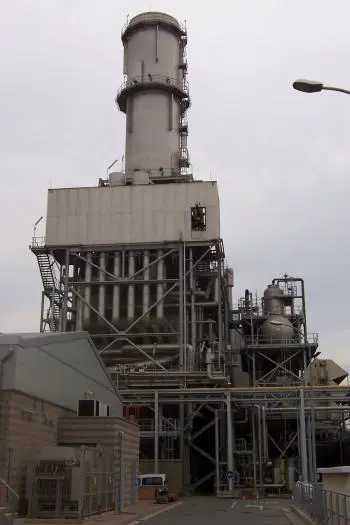
A combined cycle plant is an electrical power generation plant that uses both gas turbines and steam turbines to produce electricity. The combined cycle plant uses the heat generated by the combustion of natural gas or oil to generate mechanical energy in a gas turbine. Mechanical energy is converted into electricity through a generator.
The residual heat from the combustion of the gas is then used to produce steam in a boiler and power a second steam turbine. The mechanical energy generated by the steam turbine is also converted into electricity by another generator.
The joint use of the two turbines makes it possible to make the most of the energy generated by the combustion of fuel, increasing the energy efficiency of the plant.
How does a combined cycle power plant work?
Combined cycle power plants are an electricity generation technology that combines two different thermodynamic cycles: the Brayton cycle and the Rankine cycle.
brayton cycle
The Brayton cycle is used in the first stage of the electricity generation process in a combined cycle plant. In this cycle, natural gas is burned in a gas turbine to produce kinetic energy that is then transformed into electrical energy by a generator.
Rankine cycle
In the Rankine cycle, which is used in the second stage of the electricity generation process, the heat from the gases leaving the gas turbine is directed to a heat recovery boiler. The recovered heat is used to generate steam that drives a steam turbine connected to another electrical generator.
Advantages of a combined cycle thermoelectric plant
Among the advantages of a combined cycle plant, the following stand out:
-
High energy efficiency: By using two different thermodynamic cycles, these power plants can harness more than 60% of the energy from the natural gas that is burned, compared to 30-40% that is used in a conventional thermal power plant.
-
Lower emission of polluting gases: due to their greater energy efficiency, these power plants emit less carbon dioxide and other greenhouse gases from the combustion chamber per unit of energy produced than conventional thermal power plants.
Comparison with other types of plants
The differences between these two types of plants can be summarized in these three points:
-
Combined cycle power plants are much more efficient than conventional power plants. Therefore, the cost per kilowatt generated is lower.
-
Combined cycle power plants also emit fewer polluting gases than conventional power plants per unit of energy produced.
-
Combined cycle power plants also have greater operational flexibility than other thermal power plants and can quickly adapt to changes in power demand.
Comparison with a solar thermal power plant
Compared to a solar thermal power plant, combined cycle power plants can operate more steadily and reliably than a solar thermal power plant. Combined cycle plants do not depend on the availability of solar radiation, so electricity generation does not depend on the weather or the time of day.
In terms of energy efficiency, combined cycle plants are more efficient in terms of energy conversion than solar thermal plants. The efficiency of a solar power plant is around 25% while those of combined cycle is 50-60%.
In contrast, combined cycle power plants emit greenhouse gases during their operation, while solar energy is clean energy without gas emissions.
Another differential feature is that solar plants do not depend on any primary fuel, while combined cycle power plants need to burn fossil fuels.
Environmental impact
The environmental impact of this type of power plant is as follows:
-
Emission of polluting gases: these plants emit large amounts of carbon dioxide and other polluting gases such as nitrogen oxides and sulfur dioxide. CO2 emissions can have negative effects on air quality and human health.
-
Water consumption: a combined cycle plant needs large amounts of water for its operation, mainly to cool the steam that drives the turbines.
-
Solid waste: Combined cycle plants generate solid, liquid and gaseous waste, which must be properly managed.
-
The visual impact: the visual impact of a combined cycle plant will depend on its location and design.